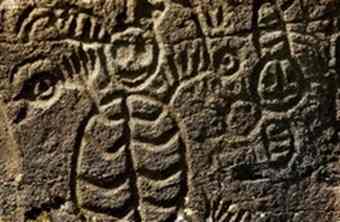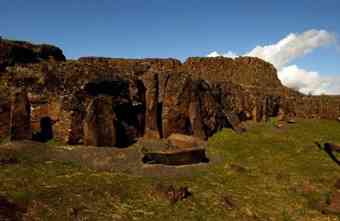If I had to name a favorite state park in the Columbia River Gorge, it would be Washington's Columbia Hills State Park. I usually visit during spring, because of the wildflowers, but the park also delights during summer with its campground, river access and petroglyph displays.
 The park, in two sections, is across the Columbia River via The Dalles Bridge (U.S. 197). Horsethief Butte is along the river and The Dalles Mountain Ranch is up the hillside.
The park, in two sections, is across the Columbia River via The Dalles Bridge (U.S. 197). Horsethief Butte is along the river and The Dalles Mountain Ranch is up the hillside.
Horsethief Butte is the location of the famous She Who Watches petroglyph, as well as a row of native rock paintings relocated there six years ago.
Nearly a half-century ago, rising waters behind The Dalles Dam forever changed a wild stretch of the Columbia River, submerging salmon-rich Celilo Falls, the Long Narrows below it and hundreds of ancient sacred petroglyphs.
The surrounding lands long had been a gathering place for people from the Warm Springs, Yakama, Umatilla, Nez Perce and other tribes. Some lived there permanently, while thousands more visited seasonally to harvest spawning salmon, to practice their religion and to join the annual opportunity to trade and socialize.
The petroglyphs -- drawings that were chipped or ground into rock to depict tribal legends, hunting scenes and mysticism -- are evidence of these gatherings. One narrow slot just above the river had so many thousands of drawings that it was named Petroglyph Canyon.
 But as the reservoir rose behind the new dam, most of these rocks were covered by water. A few were pried away and stored at the dam, perched against a wall of the fish ladder beneath roosting birds -- not a fitting home for what tribal elders consider sacred icons that provide a cultural connection between modern people and their ancestors.
But as the reservoir rose behind the new dam, most of these rocks were covered by water. A few were pried away and stored at the dam, perched against a wall of the fish ladder beneath roosting birds -- not a fitting home for what tribal elders consider sacred icons that provide a cultural connection between modern people and their ancestors.
A plan to give them a more fitting, permanent home took shape in 1996, and eight years later 43 petroglyph-covered rocks were moved to Washington's Columbia Hills State Park, an hour-and-a-half drive east from Portland. The were displayed for the first time in 2004.
Lillian Pitt, a member of the Warm Springs, Wasco and Yakama tribes, remembers how she cried in 1957 as the reservoir rose to flood the sacred land of her people. She also cried, with joy this time, when she saw the new home of the rock images.
"We don't know who made the drawings, or why," said Pitt, a Portland artist whose work is featured in the Oregon Convention Center and on TriMet's Yellow light rail line. "Some are thousands of years old, perhaps made by the First People (tribes). Some images, like the deer, are obvious, but we don't know what the others mean.
"The removal and placement of the rocks has been very successful," she said. "The respect given them was phenomenal. It's great to have the move completed because it took so many years. Now the blessed rocks are clean and won't be covered by bird droppings again."
The U.S. Army Corps of Engineers, which operates The Dalles Dam, played the lead role in the $100,000 relocation project. Corps landscape artist Gail Lovell worked with tribal elders, Washington State Parks and the Bonneville Power Administration to accomplish the six-mile move to the lower unit of Columbia Hills State Park.
Formerly called Horsethief Lake, the state park is indisputably the best place to see native petroglyphs in the Northwest. The park is also home to Tsagaglalal, "She Who Watches," one of the most famous rock images in North America. Because of past vandalism, viewing of that image is limited to an escorted tour twice a week seasonally.
The park's newest petroglyph display is called the Temani Pesh-wa Trail, native for "Written on Rock." Open daily April through October, the paved, wheelchair-accessible trail is separated from the petroglyphs by a wood rail fence. Five alcoves along the 300-foot fence allow viewers to come within 20 feet of the petroglyphs.
Chipped into 5-foot-long rocks, the petroglyphs are easily visible. They depict deer, mountain sheep and the humans who hunt them. They show thunderbirds, owls, fish and a mysterious creature with long flowing tentacles.
Park officials are counting on surveillance cameras and the ever-present staff to discourage visitors from disturbing the display. Federal law prohibits removal of archaeological resources at the site, punishable by five years in prison and a $250,000 fine.
Before being displayed, the rocks were cleaned with air and water (no chemicals) by J. Claire Dean of Portland, one of North America's top ethnographic conservators, who specializes in petroglyphs and other rock images.
When the rocks were removed from storage at The Dalles Dam, they were swathed in natural fibers and trucked in a bed of gravel for protection. None was broken during the move.
Placed on gravel at the base of low cliffs, the rocks will eventually blend with the native vegetation. In this part of the Columbia River Gorge, the short spring growing season features native grasses and brilliant wildflowers.
Facing east upriver, the rocks sit within a mile from where most were taken from Petroglyph Canyon. The canyon is now covered by Lake Celilo, the impoundment behind The Dalles Dam.
When members of the Lewis and Clark expedition passed through in 1805, they noticed a settlement of 1,500 at Big Beach in the future state park. Before construction of the dam, the Columbia was placid and wide as it passed the settlement, then seemed to turn on its side as it rushed through the Long Narrows with what Clark described as a "bad whorl and suck."
The river's transition afforded a natural setting for large gatherings during late summer. The Native Americans harvested huckleberries nearby at Mount Adams, speared salmon from the Columbia and staged games on one of the rare flat spots along the river.
And they chipped designs on the rock walls of the canyons. Some of those images now have a home that closely matches the respect, awe and wonderment felt for their original site by their creators.
Columbia Hills State Park's summer season begins on a weekend closest to April 1; the lower unit has a small campground; the upper unit (formerly The Dalles Mountain Ranch) offers wonderful springtime hiking.
The Temani Pesh-wa Trail is open 9 a.m. to 5 p.m., passing 43 rocks decorated with ancient petroglyphs. The restricted "She Who Watches" Trail begins at the same parking lot. Tours are offered at 10 a.m. Friday and Saturday, April through October. Reservations are required by calling the park at 509-767-1159. For information on Washington's state parks, look on the Web at www.parks.wa.gov.
From Portland, drive east on Interstate 84 to Exit 87 for The Dalles Bridge. Cross north into Washington and drive three miles to State Route 14. Turn east and drive 1.5 miles to the park's entrance.
Author: Terry Richard | Source: Oregon Live [July 15, 2010]